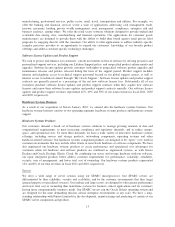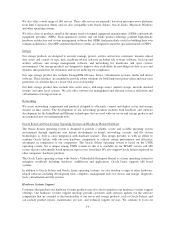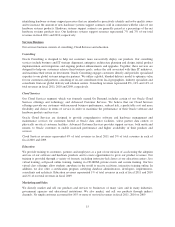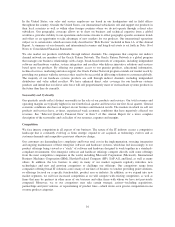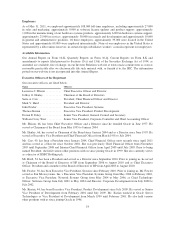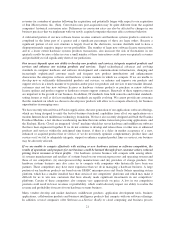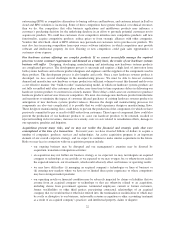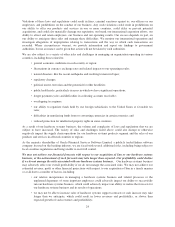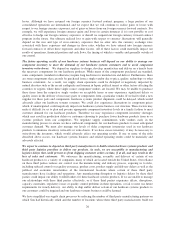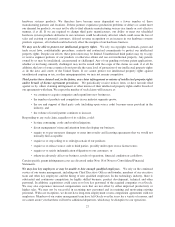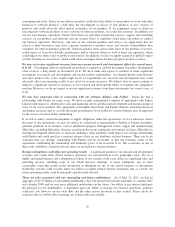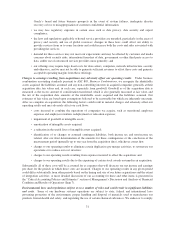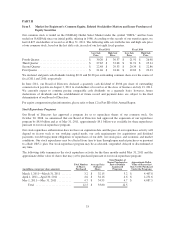Oracle 2011 Annual Report Download - page 25
Download and view the complete annual report
Please find page 25 of the 2011 Oracle annual report below. You can navigate through the pages in the report by either clicking on the pages listed below, or by using the keyword search tool below to find specific information within the annual report.• we may fail to identify or assess the magnitude of certain liabilities, shortcomings or other
circumstances prior to acquiring a company or technology, which could result in unexpected litigation
or regulatory exposure, unfavorable accounting treatment, unexpected increases in taxes due, a loss of
anticipated tax benefits or other adverse effects on our business, operating results or financial
condition;
• we may not realize the anticipated increase in our revenues from an acquisition for a number of
reasons, including if a larger than predicted number of customers decline to renew software license
updates and product support contracts and hardware systems support contracts, if we are unable to sell
the acquired products to our customer base or if contract models of an acquired company do not allow
us to recognize revenues on a timely basis;
• we may have difficulty incorporating acquired technologies or products with our existing product lines
and maintaining uniform standards, architecture, controls, procedures and policies;
• we may have multiple product lines as a result of our acquisitions that are offered, priced and supported
differently, which could cause customer confusion and delays;
• we may have higher than anticipated costs in continuing support and development of acquired
products, in general and administrative functions that support new business models, or in compliance
with associated regulations that are more complicated than we had anticipated;
• we may be unable to obtain timely approvals from, or may otherwise have certain limitations,
restrictions, penalties or other sanctions imposed on us by, worker councils or similar bodies under
applicable employment laws as a result of an acquisition, which could adversely affect our integration
plans in certain jurisdictions;
• we may be unable to obtain required approvals from governmental authorities under competition and
antitrust laws on a timely basis, if at all, which could, among other things, delay or prevent us from
completing a transaction, otherwise restrict our ability to realize the expected financial or strategic
goals of an acquisition or have other adverse effects on our current business and operations;
• our use of cash to pay for acquisitions may limit other potential uses of our cash, including stock
repurchases, dividend payments and retirement of outstanding indebtedness;
• we may significantly increase our interest expense, leverage and debt service requirements if we incur
additional debt to pay for an acquisition and we may have to delay or not proceed with a substantial
acquisition if we cannot obtain the necessary funding to complete the acquisition in a timely manner or
on favorable terms;
• to the extent that we issue a significant amount of equity securities in connection with future
acquisitions, existing stockholders may be diluted and earnings per share may decrease; and
• we may experience additional or unexpected changes in how we are required to account for our
acquisitions pursuant to U.S. generally accepted accounting principles, including arrangements that we
assume from an acquisition.
The occurrence of any of these risks could have a material adverse effect on our business, results of operations,
financial condition or cash flows, particularly in the case of a larger acquisition or several concurrent
acquisitions.
Our international sales and operations subject us to additional risks that can adversely affect our operating
results. We derive a substantial portion of our revenues from, and have significant operations, outside of the
United States. Our international operations include software and hardware systems development, manufacturing,
assembly, sales, customer support, consulting, Cloud Services and shared administrative service centers.
Compliance with international and U.S. laws and regulations that apply to our international operations increases
our cost of doing business in foreign jurisdictions. These laws and regulations include U.S. laws and local laws
which include data privacy requirements, labor relations laws, tax laws, anti-competition regulations,
prohibitions on payments to governmental officials, import and trade restrictions, and export requirements.
23


